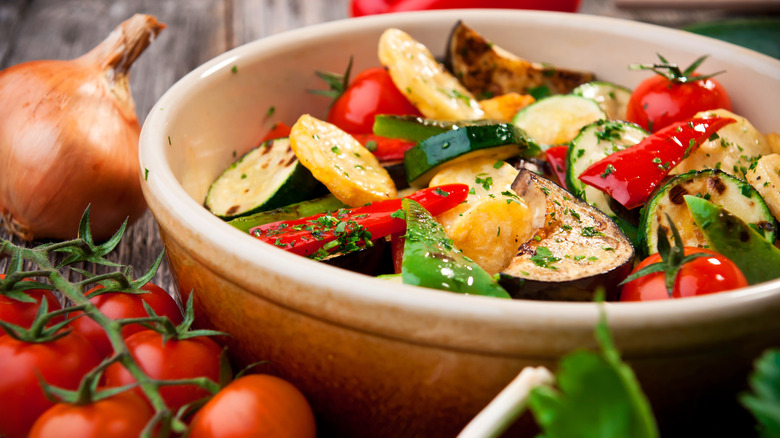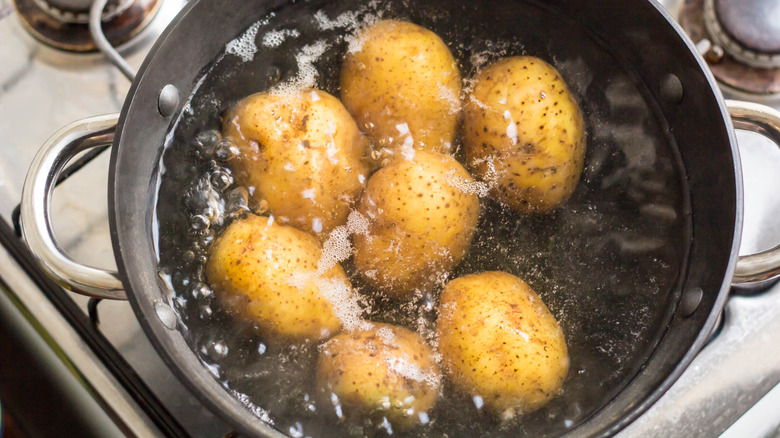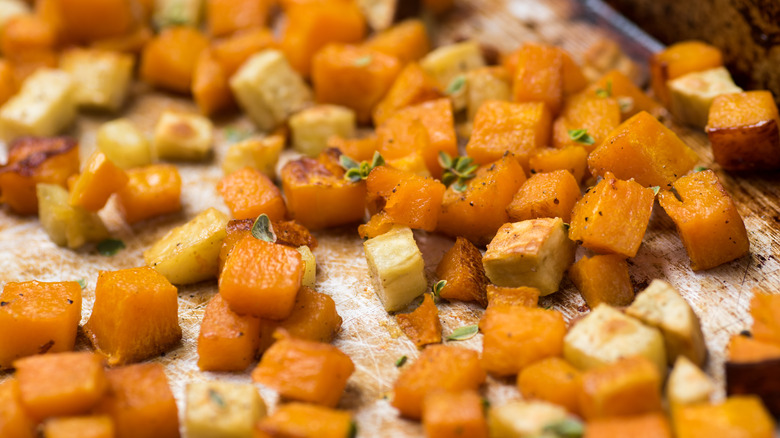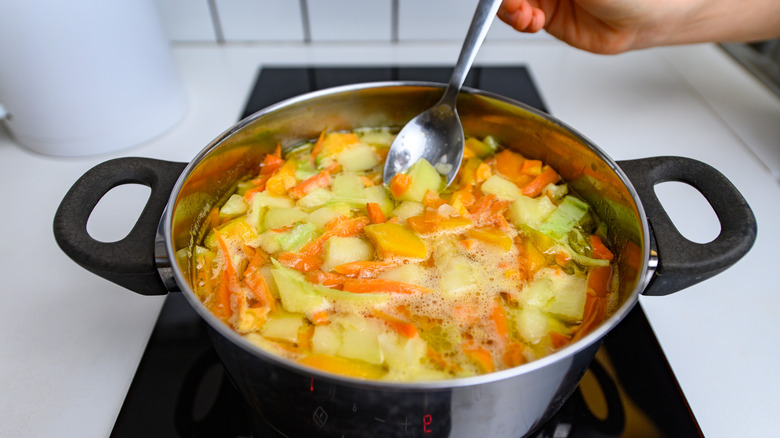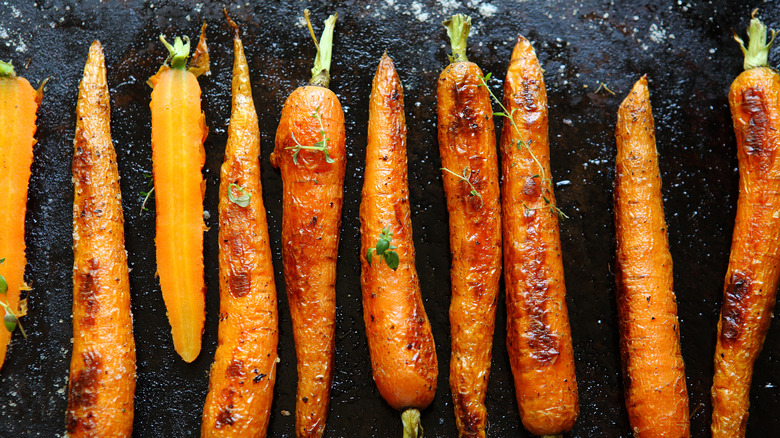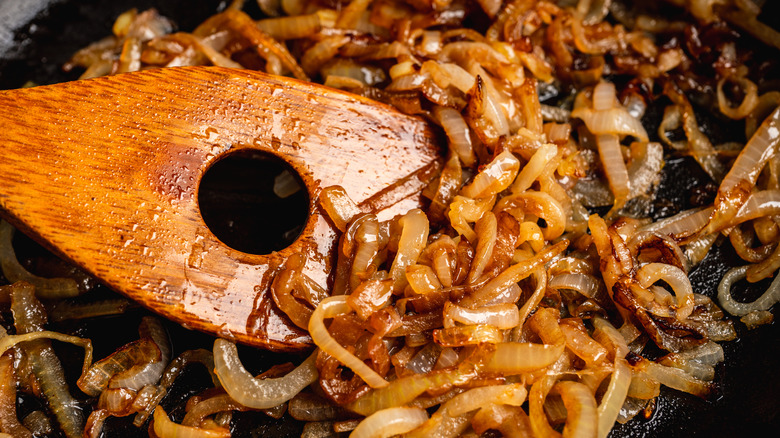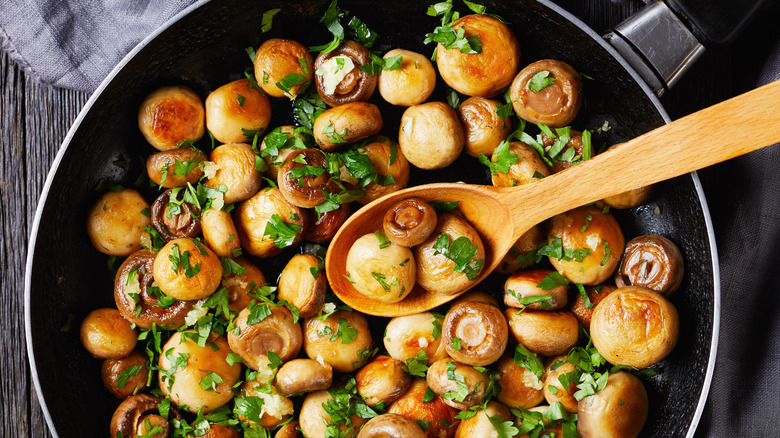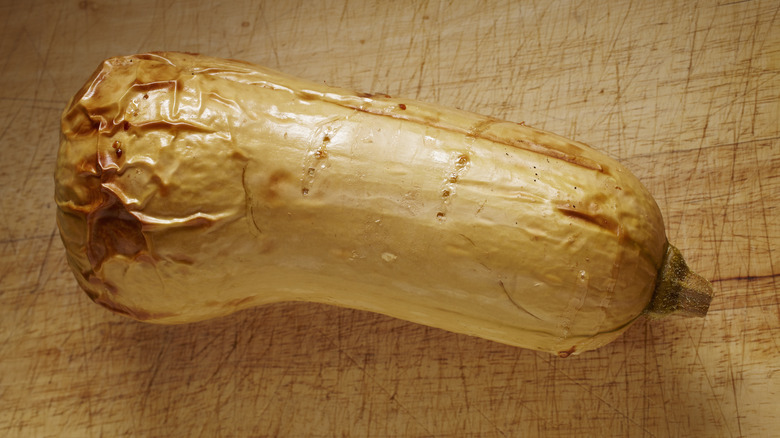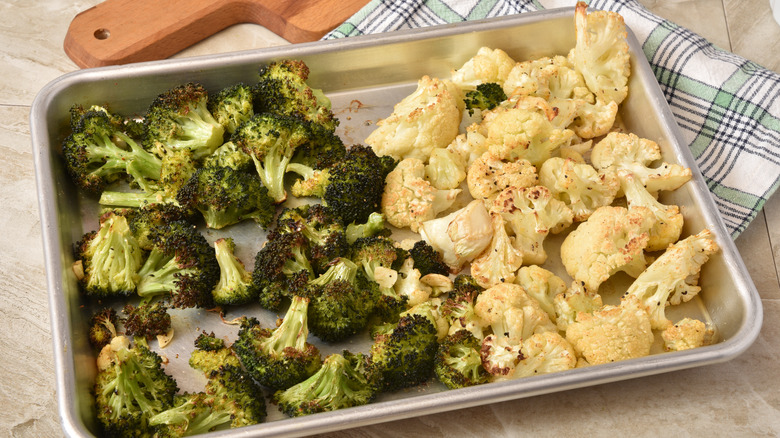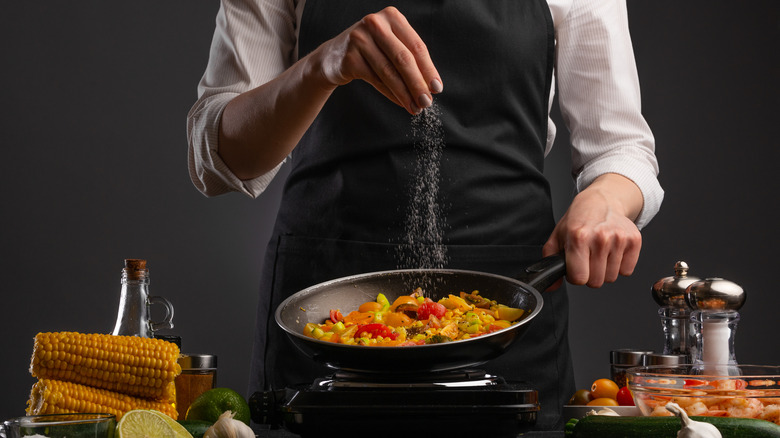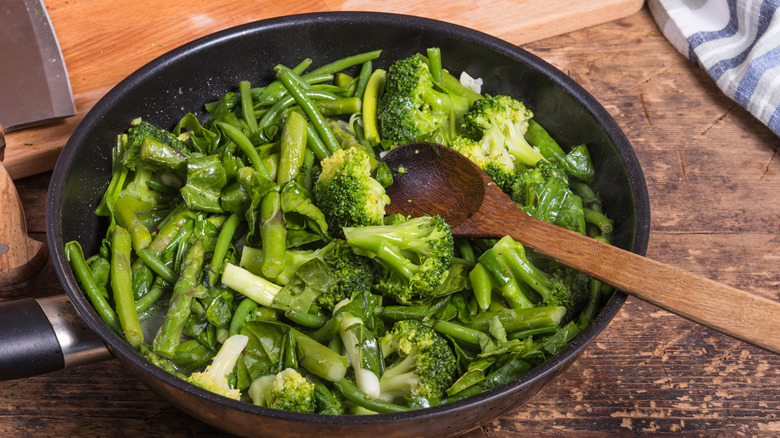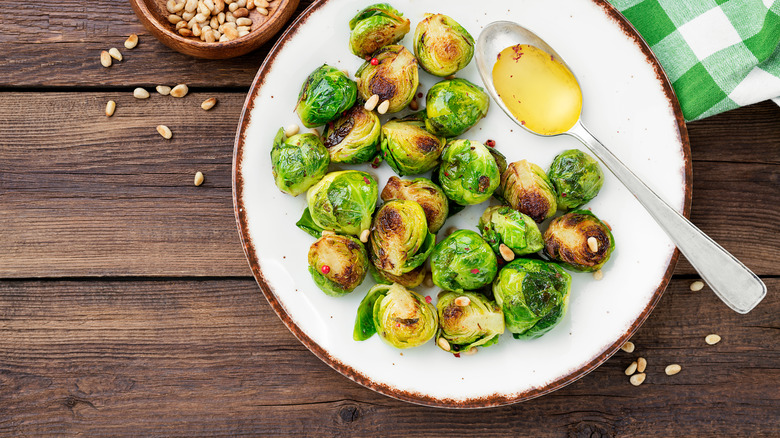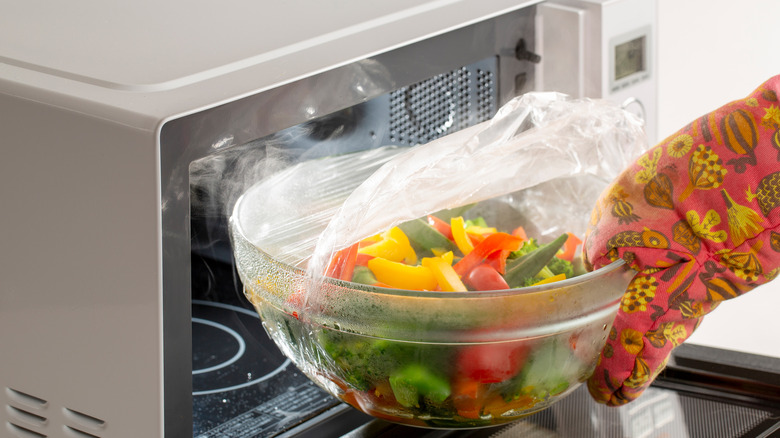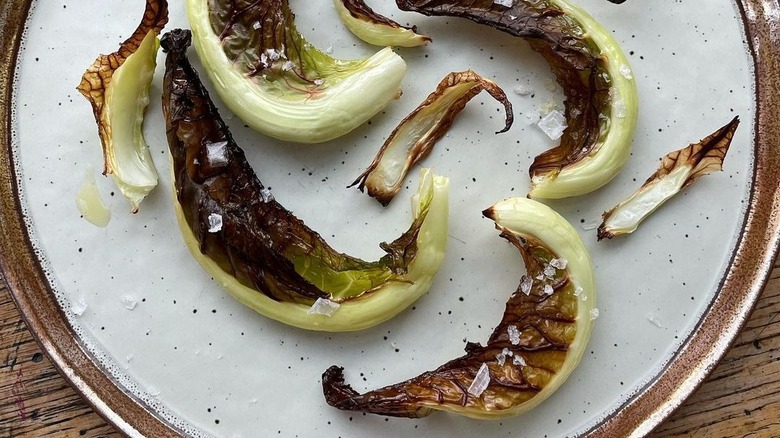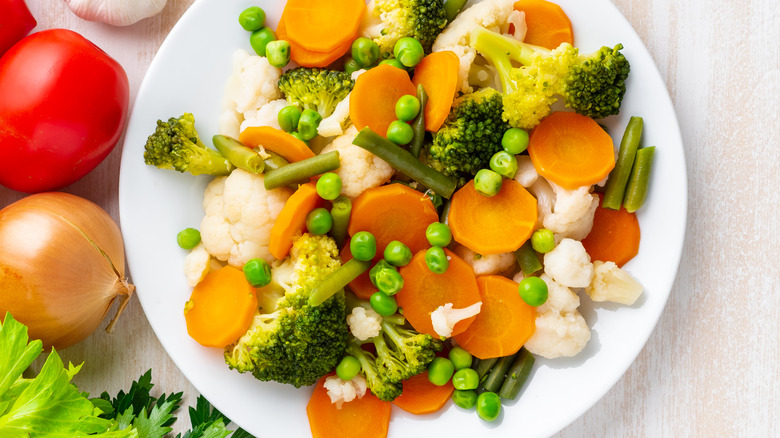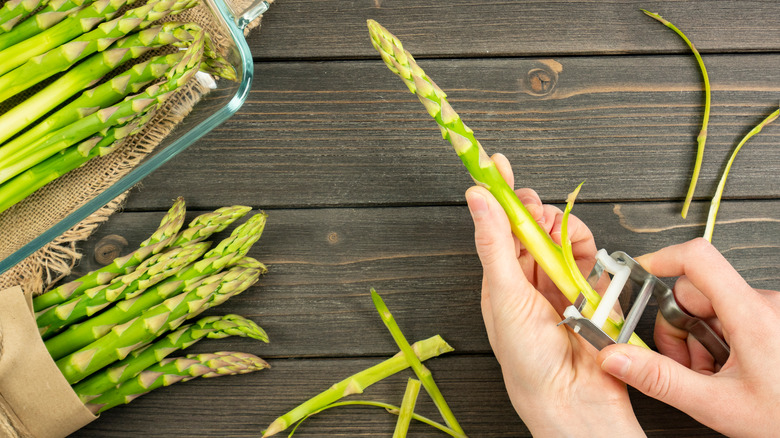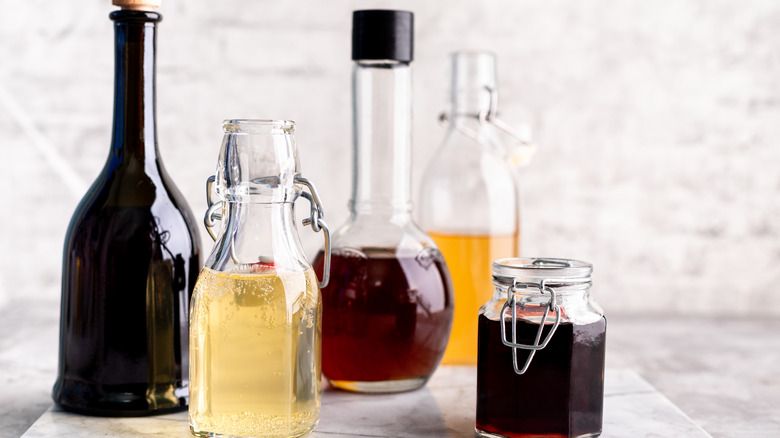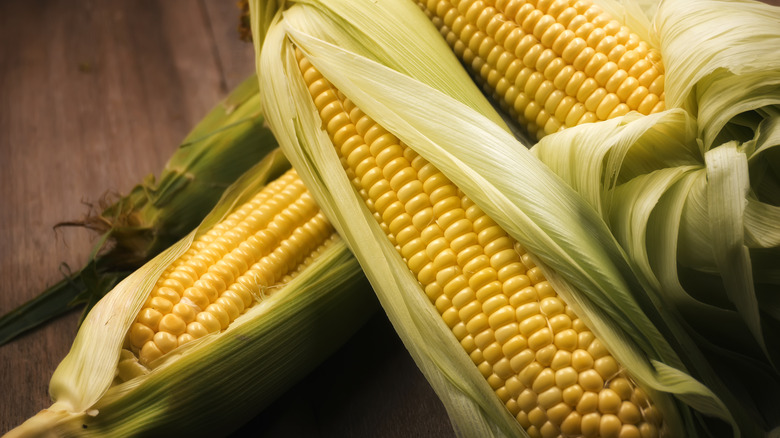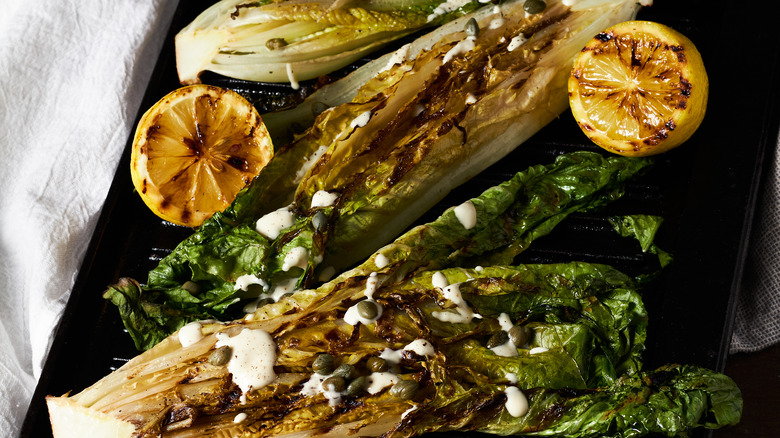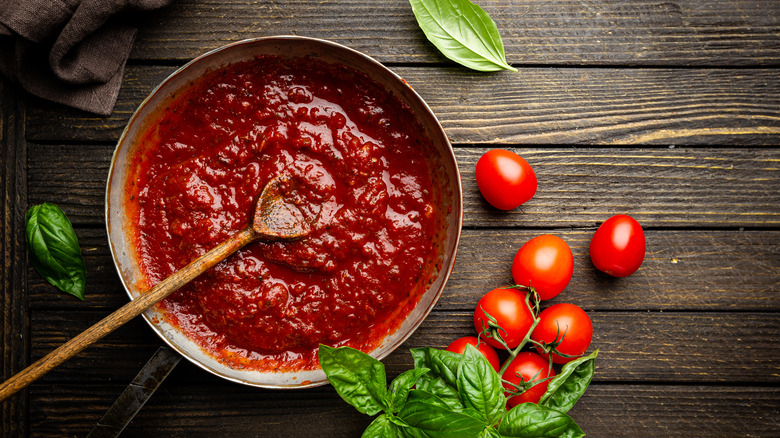19 Tips For Cooking Veggies You'll Wish You Knew Sooner
When it comes to cooking vegetables, are you on autopilot? Do you often end up underwhelmed by what you're eating? It's easy to take old standbys like potatoes, carrots, broccoli, and peas for granted — and to think you know everything you need to know about preparing them. But we bet there are some methods of cooking veggies that will both surprise and delight you on this list.
Whether you're looking for brand-new recipes or just want to brush up on the best ways to cook various vegetables (and to know why these particular methods are tops), you're in the right place. This bumper crop of intriguing ideas includes ways to enhance and preserve your veggies' nutrients, simple tricks to bump up their flavors, and tips that will make preparing them easier than ever. In some cases, they cut down on food waste as an added bonus.
So check out these game-changing tips for cooking veggies and we guarantee you'll be excited to eat your greens — and every other color of the produce rainbow.
1. You can boil whole potatoes and peel them after
The most daunting part about making mashed potatoes is peeling a mountain of spuds, not to mention cutting them into evenly sized chunks before getting the pot going. It turns out, you can skip both steps even if you're not a fan of skin-on mash. When you boil whole potatoes, you can slip the skins off with your bare hands as soon as they're cool enough to touch (scoring the potatoes around the middle first makes it even easier). Impatient cooks can don heat-proof gloves and/or use a paper towel while they're still too hot to handle.
The Kitchn claims boiling whole potatoes has other benefits too: more intense flavor since the skin has locked it in, and flesh that absorbs less water so it can soak up more butter and cream later on, while also boasting a better texture. Bookmark this one for Thanksgiving for sure, but know that you can also pre-boil whole potatoes to make peeling them easy without cooking them all the way through — useful if you want to add them to stew or roast them later.
If you're a fan of earthy-sweet eats, the same trick applies to beets.
2. It's best to roast vegetables on an unlined baking sheet
Roasting vegetables is an incredibly easy method of preparation that results in incredibly delicious crispy bits and deeply caramelized flavors. While it's tempting to line your baking pan with aluminum foil, parchment paper, or even a silicone mat to make clean-up easier, the downside is less delicious vegetables. Food52 tested the best way to roast veggies and found that using a naked baking sheet resulted in "the crispest, most burnished edges."
If you're dealing with extra-delicate produce like thinly sliced onions, you might want to line the pan precisely to stop your veggies from getting too brown and crispy. It's good to line the pan for super juicy things like roasted tomatoes too. But for those times when sticky, crunchy edges and golden-brown blotches are the whole point, skip that step. A baking soda scrub will clean off any stuck-on bits, but a well-seasoned baking sheet — like a well-seasoned cast iron skillet—is actually a good thing, so don't stress too much about a baked-on patina. (And whatever you do, don't put your baking sheet in the dishwasher.)
One more tip to ensure the best roasted vegetables ever: avoid deep baking pans and use a baking sheet with lower sides so steam doesn't get trapped and inhibit caramelization.
3. Boiling vegetables in broth instead of water adds major flavor
This is such a simple tip, it might seem silly — but it's also second nature to just turn on the tap when you need a liquid cooking medium for your veggies. In general, boiled vegetables tend to be less exciting and less nutritious (since many vitamins and minerals leach out into the cooking water), but sometimes it's an ideal method.
Swapping in stock or broth instead of using plain water adds a ton of flavor when you're slow-cooking greens, boiling spuds for mashed potatoes, or braising carrots. When you use this trick for a recipe that originally calls for water, though, you'll likely need less salt in the finished dish, so be sure to taste your veggies before adding seasoning. You can also save your extra-flavorful broth that's left behind for a quick soup down the line; cool it and freeze it if you don't plan to use it within the week.
When you're employing a quicker cooking method, or one where your produce doesn't actually end up soaking in the liquid, like blanching, poaching, or steaming, it's not worth switching up your usual water bath.
4. You don't have to peel carrots or other root veggies before cooking them
Most of us automatically reach for the vegetable peeler when we're getting ready to cook carrots, potatoes, sweet potatoes, parsnips, and squash, but it's not really necessary. As long as you give them a good scrub with a stiff-bristled brush to banish all traces of dirt and bacteria, these skins and peels are perfectly safe to eat. In fact, they provide a nice boost of nutrients and additional dietary fiber.
Skin-on vegetables, of course, will have a noticeably different taste and texture, and you might not be a fan. For instance, Cooks Illustrated is in favor of peeling carrots since some people thought the unpeeled carrots were dusty, bitter, and tough — but it's at least worth a try so you can find out where you fall. Even some winter squashes have thin enough skins you can leave them on when cooking and eating them. Check out this roasted delicata squash recipe for proof.
If you remain unconvinced but do feel guilty about throwing out your veggie peels and just aren't a composting kind of person, try making vegetable skin chips for a fairly healthy, zero-waste snack.
5. A little baking soda speeds up caramelized onions
Caramelized onions are a magical ingredient that brings an amazing depth of sweet-savory flavor to everything from pizza and pasta to classic dip, French onion soup, and special sandwiches. You can make them ahead of time and keep them in the fridge for when you need them, but there's no getting around the fact that caramelizing onions take a long time (if you're cooking them properly).
Serious Eats found that you can make caramelizing onions more efficient by adding a pinch of baking soda to speed up the browning process. Because baking soda helps break down the pectin in the onions, this also makes their texture even softer in the end.
Adding a pinch of sugar to the pan can enhance the onions' sweetness but won't make the actual cooking process faster — unless you melt it into a thin caramel first and then add the onions. If you're not wary of burning your sugar, try combining both tips to save even more time.
6. You can cook mushrooms in water to make them better (and better for you)
Mushrooms and water shouldn't mix, according to conventional wisdom. Because fungi are so spongy, they can easily become waterlogged — so you're advised not to even wash them (but clean them off with a damp paper towel or soft-bristled brush instead). In fact, there's no worry about washing whole mushrooms, and if you're buying them pre-sliced, they're already clean anyway.
Even so, the thought of pouring ¼ cup of water into the sauté pan with your shrooms may seem shocking. But Cooks Illustrated says it's the best way to go, because it ensures the mushrooms release the moisture already in their cells while starting to cook down, so that by the time the liquid in the pan evaporates, you can add oil and/or butter to brown the buttons, creminis, or portobello pieces without turning them into grease-soaked fat bombs. However, you won't lose any flavor.
7. You can cook a whole butternut squash to make peeling and slicing easier
Butternut squash is a fall all-star for good reason. Its vivid orange flesh is striking and naturally nutty and sweet, and it's perfect in cozy dishes like soup and roasted preparations. It is, however, pretty unwieldy, with an irregular shape and tough skin that make peeling precarious, and an overall density that makes a scimitar seem like a more likely tool than a knife for cutting into it.
But a lesser-known beauty of butternut squash is that you don't have to peel it or cut it before cooking, particularly if you plan to puree it into soup, sauce, or ravioli filling.
You can roast the whole squash without doing anything other than poking a few holes in to let steam escape and stop it from exploding in your oven, then easily strip the skin away and scoop out the seeds once it cools. If your oven's occupied or out of commission, you can also cook a whole butternut squash in your slow cooker. However, if you're after uniformly caramelized chunks of roasted flesh, you can microwave a whole butternut squash for just a few minutes to make the skin easy to peel before chopping up the squash to cook.
8. You can roast frozen vegetables
Frozen vegetables are worth keeping around if only for those times when you don't want to spend a single extra moment washing, peeling, and chopping produce but desperately need some roughage — or when you find your crisper drawer empty between store runs. While microwaving frozen veggies is probably the most common way of cooking them, if that's a bit too blah, you can roast them in the oven.
They will certainly be softer than if you started with raw veggies, but they can still get caramelized edges no microwave could ever impart. The keys to actually getting crispy bits are to preheat your unlined baking sheet in the hot oven (a good trick to employ when roasting raw vegetables too), and to thoroughly coat your frozen veggies in oil— no need to thaw! Also, be sure not to crowd your pan, since steam is the enemy here.
If you don't feel like turning on your oven, cooking frozen vegetables in an air fryer can produce similarly crisp-edged results.
9. It matters when you salt your vegetables
Salt is essential for bringing out flavors in food, but when you add salt it can affect the cooking process itself, and hence the texture and taste of your finished dish. When it comes to vegetables, their density and moisture content have a lot to do with figuring out the best time to add salt, as does your cooking method.
When sautéing more delicate, watery produce like zucchini, peppers, or onions, The New Baguette advises against salting right away, since the salt will draw moisture out and make the veggies steam, which will inhibit caramelization. Many recipes suggest salting certain produce, like eggplant or cabbage, at least 10 minutes or so ahead of time precisely to draw out excess moisture before it ever has a chance to meet heat and turn to steam.
Denser, drier items like root vegetables can take salt earlier in the cooking process, and in fact, will benefit from it. Cooks Illustrated compared roasted carrots that were salted before cooking to those that were salted after and found that they were "drastically different," with the pre-salted carrots turning out "properly seasoned and flavorful throughout."
10. Crowding your pan is a recipe for disaster — with some exceptions
We've mentioned the moisture content of various vegetables more than once, but it's an important factor to keep in mind, particularly whenever you're sautéing or roasting. Putting too many pieces of any given veggie in your skillet or on your baking sheet will create and trap steam. That steam will make things soggy and prevent proper browning, which in turn will really mute the flavor.
Sometimes it won't matter much in the end, like if you're caramelizing a mass of onions (it'll take longer for them to start cooking down but you'll still get the same golden brown result eventually). Other times, your stir-fry will never be the same. Cook in batches if your pan will otherwise be overloaded and you'll end up with a much tastier meal.
However, if your goal is just to cook things down — say, you're wilting spinach or sweating vegetables for a soup — then don't shy away from the crowd, and harness the power of steam to help you.
11. Adding fat can actually make vegetables healthier
Butter makes almost everything taste better, but can it actually make food healthier for you? It sounds counterintuitive, but yes, it's true and the same goes for oil too. Some fat-soluble vitamins (A, D, E, and K), minerals (including calcium, potassium, and zinc), and carotenoids (like the beta carotene in carrots) need a little help to be coaxed out of our food and absorbed by our bodies. Fine Cooking likens it to "a nutritional buddy system" and notes that adding citrus to iron-rich veggies serves a similar purpose.
This doesn't mean deep fried onion rings count as health food, but it is a good reminder not to be afraid of cooking with a moderate amount of fat. This guide to cooking oils will help you choose the best one for the job, but feel free to use this knowledge as a license to drizzle a little more vinaigrette on your salad too.
12. You can steam vegetables without any specialized equipment
We just gave fat props for its unexpected health benefits, but sometimes you want something a little leaner. Steamed vegetables are simple, easy, good for you, and, when done right, have a great crisp-tender texture. But what if you don't have a steamer basket? As Food 52 demonstrates, it's not all that tricky. Break out a big pot and one or two additional pieces of common kitchenware (either a metal strainer or metal baking rack, or, failing either of those, a heatproof plate and some balled-up aluminum foil).
Another option is to steam veggies in the microwave using a bowl and plastic wrap. Whichever way you go, cutting your vegetables into at-least-roughly uniform pieces is a must (and that's true for every preparation method). If you're mixing vegetable types, be sure they're also of a similar density so they cook at the same rate. And finally, be careful around the steam itself, as it can cause nasty burns.
13. You can cook your cauliflower leaves for a real treat
In the very best cases, finding ways to reduce food waste proves just as rewarding for the taste buds as for the environment (and for the wallet, of course). Take cauliflower leaves. If you've been tossing them in the compost or the garbage bin, cut that out and keep them on your cutting board instead.
Since they're fairly sturdy, you can store them in the fridge for a few days and use them in a stir-fry, where their juicy, snappy-yet-tender texture is similar to celery or bok choy, or chop them up and simmer them in a soup. Roasted cauliflower leaves are especially good and easy to tip right in along with your florets if you're already roasting them too.
One caveat: if you're buying extra-rustic cauliflower from a farmers market — or growing your own — the very outer layer of leaves might be too tough and stringy to enjoy, even cooked, but the paler green ones are fair game.
14. There's an easy rule for remembering when to use cold water vs hot water
If you always have to look up whether it's best to start your pot of potatoes in cold water or hot water, The Farmers Almanac has a handy tip to help you remember. You should add vegetables that grow in the chill below ground (like those potatoes and other root veggies) in a pot of cold water, while veggies that grow in the warmer air above the ground (like corn, peas, and green beans) should be added to a pot of boiling water for a quicker cooking session.
This is because vegetables grown underground tend to contain a much greater amount of starch and require a longer cooking time. Starting them off in cold water allows their temperature to rise gradually so they cook evenly, whereas already-boiling water will gelatinize the veggie's starches too quickly, creating "a mushy exterior that falls apart" before the center is thoroughly done.
15. You should use your vegetable peeler on celery, asparagus, and broccoli too
Even if you decide to stop skinning carrots, you should keep that veggie peeler on hand for other things, like making chocolate and cheese shavings, slicing zucchini ribbons, and creating citrus peel garnishes for your drinks. Break it out when you're preparing broccoli, asparagus, and celery too.
Much like cauliflower leaves, broccoli stems are often thrown out but are perfectly edible — though sometimes the outer layer of skin is a bit gnarly and dense. Simply remove it with the vegetable peeler and chop the remaining stalk to roast, sauté, or steam along with the florets.
For celery, a veggie peeler makes removing any stringy bits easy. And with asparagus, even once you snap off the woody ends, fatter stalks can still have a tough, fibrous outside. So use your vegetable peeler to shave off the less-edible layer where the stalk is particularly thick (but stop well shy of the tender tips).
16. A dash of vinegar does a lot of different things for various vegetables
Like salt, vinegar can change not only the taste but the texture — and even the appearance — of your food. Here are some of the ways it comes in most handy for vegetables, besides dressing salads and pickling pretty much anything:
Adding a splash of vinegar to a pot of boiling potatoes helps keep their texture from turning to grainy mush, a great trick for potato salad in particular. On the advice of Serious Eats, "a tablespoon of vinegar per quart of water" is enough to keep potatoes from overcooking. Spiking your water with vinegar also keeps cauliflower bright white, a big bonus if you're using it on a veggie platter where pretty presentation matters.
Vinegar is a stand-out secret ingredient for roasted vegetables, where its in-your-face acidity will mellow out in the oven while leaving your veggies with an alluring extra something-something. While plain old white vinegar works just fine for all of these applications, this is where you can (and should) experiment with all the other kinds in your pantry as well.
And circling back to spuds, try adding a spritz of vinegar to your mashed potatoes, where something more subtle, like apple cider or malt vinegar, will work best. According to Food52, it "transforms the mash," much like adding a finishing squirt of lemon or lime does to many dishes.
17. Microwave corn on the cob for a super easy summer side
You already know you can steam perennial go-to sides like broccoli and carrots in the microwave, but when summer is in full swing and corn is in season, the ubiquitous kitchen appliance is once again a good friend. Boiling and grilling ears of corn will never go out of style, but when you're in a hurry and only need a few ears at once, you can cook corn on the cob in the microwave for a reliably quick and delicious summer side dish.
All you need to do is rinse the corn — still in the husk — and pop the cobs in the microwave on high for a few minutes. They'll emerge tenderly steamed, full of sweet corn flavor, and those pesky strands of silk will slide right off. Cut off the bottom of the cob to make removing the husk even easier after it's been nuked to perfection.
18. You can (and should) cook lettuce and cucumbers
Cooking veggies isn't the only way to enjoy them, of course. Salads are perfect for showcasing raw produce — but some of the crunchy, fresh ingredients that normally go straight into your serving bowl taste brand new again when you apply some heat.
While juicy, crisp lettuce may be the least likely candidate for cooking in the American kitchen, salad leaves take well to several cooking methods, including grilling, braising, and stir-frying. Grilled romaine lettuce is an amazing base for a charred Caesar salad. Braised lettuce is supremely soft and tender (and a good way to deal with already-wilting greens). And stir-fried lettuce is a common Chinese preparation that's fantastically easy and delicious.
You can do all the same things to similarly crisp and watery cucumbers, too. So next time you're hungry for something different, try Korean stir-fried cucumbers or grilled cucumbers for a change.
19. You should never cook tomatoes in aluminum pots and pans
Technically, tomatoes (like cucumbers, avocado, and corn) are fruit, but we treat them as a vegetable and cook them into lots of sauces, soups, and other savory dishes. When you're making a ragu or roasting tomatoes, though, you should make sure you're not using aluminum pots or pans.
The health risks aren't as great a concern as you might have heard, but the acid in tomatoes does react with aluminum and will cause pits in your cookware. Plus, it may create a bitter or metallic taste in your food. (Incidentally, if you've ever noticed little holes in the aluminum foil you've used to cover your leftover lasagna, it's caused by the same reaction and the acidic tomato sauce has turned specks of foil into aluminum salt.)
Use stainless steel, enamel-coated, or anodized aluminum to cook tomatoes for best results. Despite persistent advice, you can cook tomatoes in cast iron too— for short amounts of time and if the skillet is well-seasoned.
